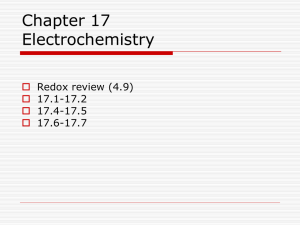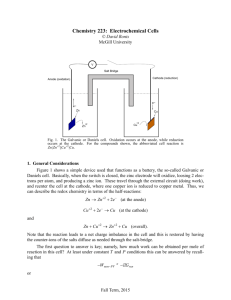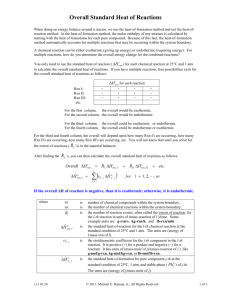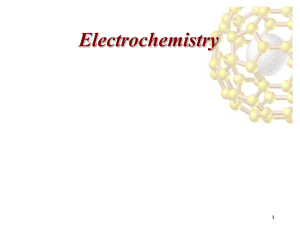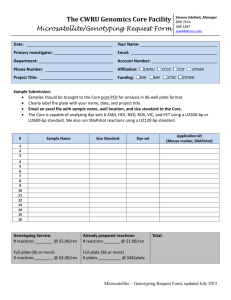Quiz Wed
advertisement
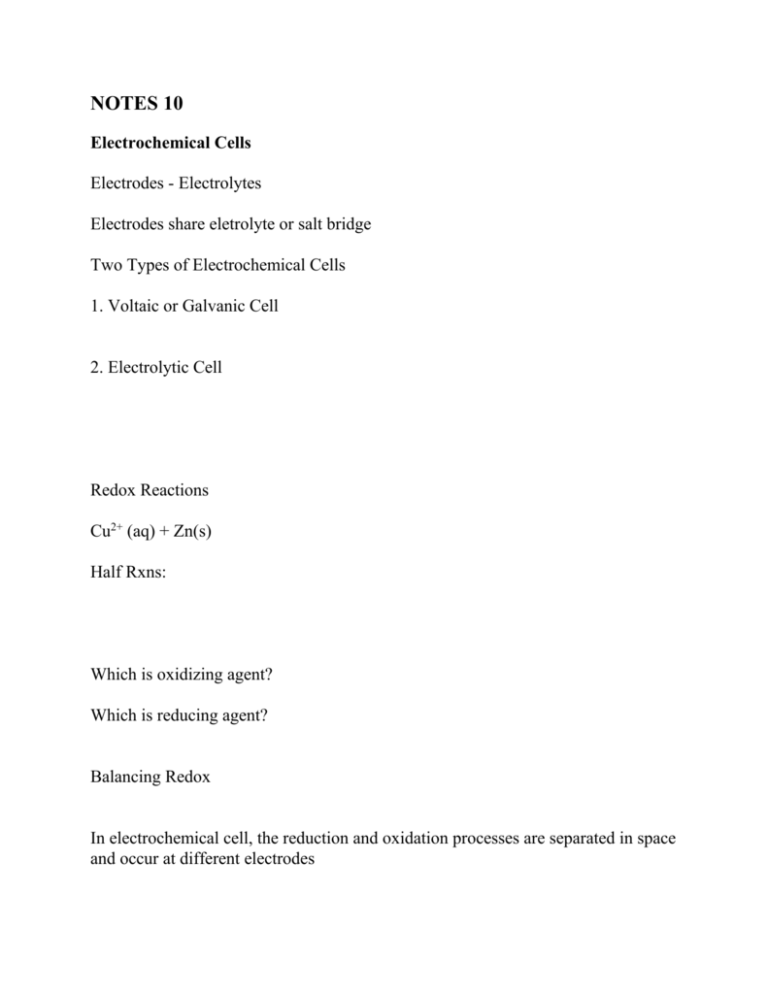
NOTES 10
Electrochemical Cells
Electrodes - Electrolytes
Electrodes share eletrolyte or salt bridge
Two Types of Electrochemical Cells
1. Voltaic or Galvanic Cell
2. Electrolytic Cell
Redox Reactions
Cu2+ (aq) + Zn(s)
Half Rxns:
Which is oxidizing agent?
Which is reducing agent?
Balancing Redox
In electrochemical cell, the reduction and oxidation processes are separated in space
and occur at different electrodes
The spontaneity of the overall process can be harnessed - electrons flow externally
Potential of Cell - essentially the potential for the electrons to flow (current)
producing work
Anode - electrode at which ___________ occurs
Cathode - electrode at which ___________ occurs.
Galvanic Cell - cathode has higher potential than the anode
Since reduction is occurring there (spontaneously) then electrons must be drawn to
it so
anode is ____________ and cathode is __________
Electrolytic Cell now reduction is not spontaneous so electrons must be supplied
for the cathode meaning
the _______________ side is connected there
Varieties of Cells
1. Single electrolyte common to both electrodes
2. Immerse electrodes in different electrolytes
Additional Potential E1j - liquid junction potential - interface potential - minimized
by salt bridge
3. Electrolyte Concentration Cell
4. Electrode Concentration Cell
Cell Notation
/ vertical bar - phase boundary
:
liquid junction (with Elj)
// junction where El i is eliminated (no salt bridge)
Make notation by putting
anode left ....................cathode right ......................................... For Galvanic Cell
(__________ as written)
.
Include Concentration in notation
So concentration cell made up of H2(g) cells at diff conc of Hcl is
What about this cell. What is anode rxn? Cathode rxn? What type of cell?
Zn(s) / ZnSO4(aq) // CuSO4(aq) / Cu(s)
As stated - for Galvanic Cell, the spontaneity of the process can be harnessed to to
work since electrons flow externally
The potential for work is the potential difference between the electrodes - cell
potential measured in Volts.
We know that we max is related to G(T,P) for reversible case
Measure zero current potential E - emf
E & rG must be related
Work = transported charge x potential difference
If rxn advances dthen vdelectrons must travel form anode to catlode
on per mole basis
so work = v d F E = e
dG/d=
Thus
dG =
-v FE =
Knowing the reaction Gibbs Energy at a specified fixed composition - can state the
zero current potential at that composition
negative rG is spontaneous in forward direction so positive E is _____________\
r G =
E=
-vFE0 =
E=
Tells
Since Gorxn =
-vFE0
K=
Kinetics
Study of Rate of a Rxn. Thermodynamics tells only about spontaneity, not rate
Guldberg and Waage in 1864 “reaction rate is proportional to the “active masses” of the
reactants. (More Complicated)
Expressing the rate of a reaction:
Consider the reaction: H2O + N2 + 5/2 O2 -> 2HNO3 ......... Grxno = 85 kcal/mole
Ocean? Is this reaction spontaneous?
Since 1 mole of N2 reacts with 5/2 mole O2
..................... - d [N2]/dt = -2/5 d[O2]/dt? [] mean concentration
Or for a general reaction like: aA + bB <--> cC + Dd
Could Express the rate of rxn in terms of any of the four species
(Defined for a particular direction)
forward = -d[A]/dt or perhaps - d[C]/dt
The rate expressions are related by the STOICHIOMETRY
rate = 1/a d[A]/dt = -1/b d[B]/dt = 1/c d[C]/dt = 1/d d[D]/dt
Generally: = 1/i d[I]/dt (Where i is negative fo reactants and positive for products.
Example:
Consider the rate of consumption of CH3 in the rxn:
................................... 2 CH3(g) -> CH3CH3
d[CH3} was reported to be 1.2 mol/L. What is the rate of the reaction and the rate of formation of
CH3CH3?
For Many Reactions:
it has been found that the rate can be expressed by an eqn. like = k[A}m{B]n
k is known as the rate constant
m & n are not necessarily the reaction stoichiometric coefficients
(THEY ARE DETERMINED BY THE RXN MECHANISM: the basic steps necessary for the
reaction to occur)
An example of this point is given by:
H2 + I2 -> 2HI
H2 + Br2 -> 2HBr
It turns out that the rate expressions are given by:
HI) =
(HBr) =
Evan though the overall reaction is the same for the formation of HI and HBr, the mechanisms
(basic steps) must be different and so the rate expressions are different.
Definitions:
Order of reaction with respect to some component is the _____________ to which the conc. of
that component is raised in the rate law.
In HI, what is the order with respect to I2? H2?
In HBr, what is the order in H2? How about Br2 and Hbr?
The OVERALL ORDER is the sum of the order of all components.
What is the overal rxn order for HI? How about HBr?
Example: What would be the overall order of the reaction of
10 PH3 -> P10 + 15 H2?
If the rate law is = k?
The rate eqns. are differential eqns. that can for the most part be integrated directly.
1st order
................ -d[A]/dt = k[A]
Separation of variables
A Plot of _____________ vs ______________ gives a straight line.
Or
The half life for a rxn is the time, t1/2 whn half (½) the initial amount has reacted:
Sometimes it is convenient to express the rate eqn. In terms of a concentration change - change in
A vs time t.
Ao = initial concentration ..................... Let x = conc. change at time t.
x = Ao - A
What are the units on a lst order reaction?
2nd Order
2nd order in one compound ................. rate = -k[A]2
What would yield a linear plot for 2nd order rxn?
What are the units of the rate constant for a 2nd order rxn?
What about the half life?
Other type of 2nd order rxn.
...................... rate = k2 [A][B] = -d[A]/dt = -d[B]/dt
if stoichiometry is 1 to1: ................................... A + B -> P
In terms of the concentration change x:
dx/dt = k2 (Ao-x) (Bo-x)
when Ao is not equal to Bo
Straight line? Plot of ? vs t.
What happens if Bo - Ao = 0? Bo = Ao?
Must use different integration
So a plot of
Third order reactions:
There are very few rxns that are definitely known to be third order. See why later.
WAYS TO FIND THE RATE LAW FOR A REACTION
1) Trial and Error
........ Reasonable assumption made for the order and the corresponding integrated rate eqn. is
checked with the experimental data by calculating the rate constants for a number of time
intervals. If the calculated “rate” constant is actually constant, then the assumed order is correct.
Variant of this is to graph against the time the appropriate fucnts of the experimental
concentration corresponding to the various orders. The function which yields a straight-line plot
corresponds to the correct order. This is a nice technique if the following chages in order accur
as the reaction proceeds.
2) Half life - seen the different half life expressions which depend on the order.
3) Differential Method - Study x/t dependence on the reactant concentration by varying the
initial concentration of one reactant at a time Initial Rate
So assume data of [A] or ([Ao]-x) as a function of time we could determine the overall order of
the reaction by trying the various plots or looking at the half life.
Or look at initial rates
Rate of reaction A + 2B -> C has been observed at 25oC . From the following data, determine
the rate law for the reaction, and calculate the rate constant.
Exper.
Initial [A]
Initial [B]
Initial Rate
1 .............................0.100 ..................... 0.100 ........................ 5.5 x 10-6
2 .............................0.200 ..................... 0.100 ........................ 2.2 x 10-5
3 .............................0.400 ......................0.100 .........................8.8 x 10-5
4 ............................ 0.100 ......................0.300 .........................1.65 x 10-5
5 ............................ 0.100 ......................0.600 .........................3.30 x 10-5
Assume that the rate equation only has the reactant concentrations in it. In some cases this well
be a bad assumption. (Think of Hbr) so rate = k[A]x[B]y
Pick two experiments say 1 and 2 (conc. of B is held constant) so double the initial concentration
of A: rate increases by
Exper. 4 and 5 shew that doubling the intial conc. of B (holding A constant between
experiments) doubles the rate. Thus y=1 and x = ________/
So the rate law is:
This is really only useful for determining the rate law at the initial point in the reaction, and only
for simple rate laws.
The other methods (graphical and half life) only work well for simple rate laws. 1st order, 2nd
order, 3rd order or half orders.
Example:
What is the half life of a zeroth order?
For a second order reaction rate = k[A][B] allow (for instance) Ao>>Bo, then A is not depleted
and A-Ao always.
then rate = k[A][B] = k[Ao][B] = k’[B]
where k’ = k[Ao]
Called a pseudo first order reaction
Typical example:
R1COOR2 + H2O -> R1COOH + R2OH
....................excess H2O
Examples:
Rate Constant Itself
1) Is it really a constant?
2) If we have more than one reaction combined to produce an overall reaction, what is the rate
constant?
3) How is the rate constant of the reverse reaction related to the rate constant in the forward
direction?
Found from experiment: Rates of reaction generally increase with increasing temperature!
Usually rate constant is from 1.5 to 4.5 times large for every 10oC rise in temp.
1.5 < k35/k25 < 4.5
Temp. dependence of rate constant first suggested in 1889 based on analogy with van’t Hoff’s
eqn.???
dlnKeq /dT = Hrxn /RT2
dlnk/dT = Ea/RT2
Found from experiment that often reactions follow the Arrhenius equation:
lnk = lnA - Ea/RT .................... or ....................... k = Ae-Ea/RT
A = pre-exponential factor or frequency factor
Ea = activation energy
Related to bimolecular collisions - since we’d find that the number of collisions/cm3s between
unlike molecules whose relative Kinetic Energy is greater than Ea is given by
Z’ab = Zab eEa/kT
Remember the Kinetic Theory of Gases in Chp. 24. Maxwell-Boltzmann Distribution of
molecular velocities. Remember that Zab was related to the mean free path!
In terms of the kinetic theory, Ea is Ec*, the energy above which reaction may occur. Ec* = ½
mvc2*
Diagram of what Ea is all about.
So theoretically we can get Ea and A.
How can we determine the activation energy and the frequency factor experimentally?
Measure __________ at several different _____________. Then a plot of _________ vs
_________ gives a straight line with slope ______________ and intercept ___________.
